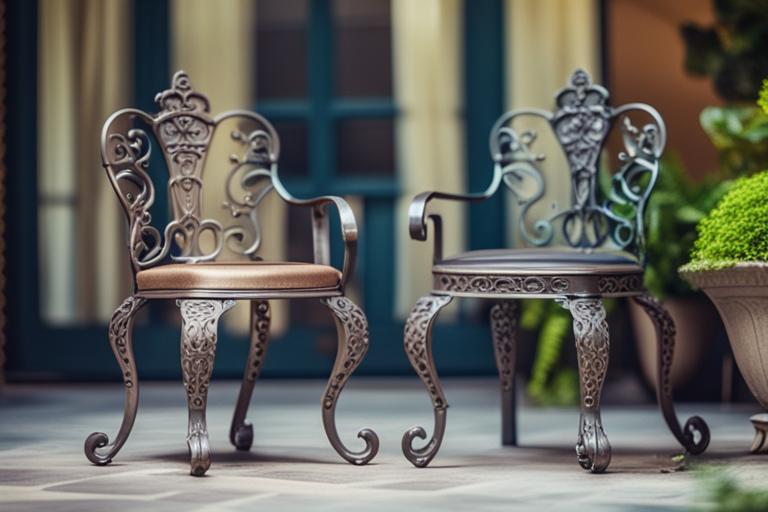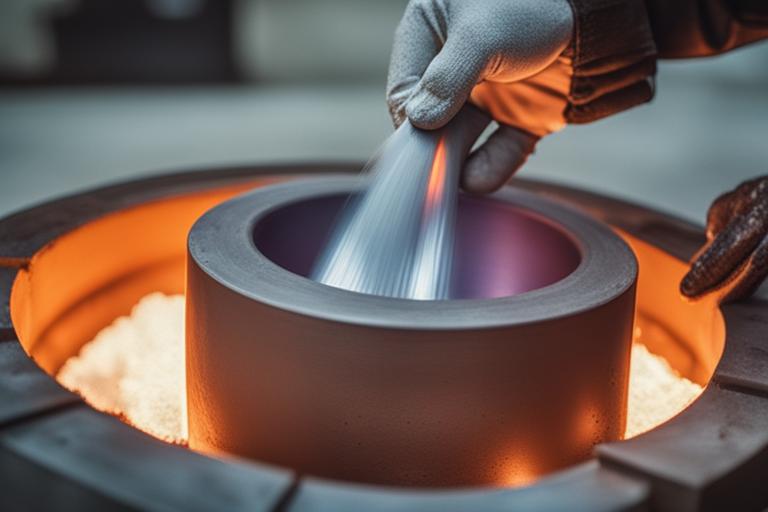If you’re in the market for new outdoor furniture, you may be wondering which material to choose between cast aluminum and wrought iron. Cast aluminum and wrought iron are both popular choices for outdoor furniture and decor due to their durability, strength, and aesthetic appeal. In this article, we’ll explore the differences between cast aluminum and wrought iron, including their manufacturing processes, durability, maintenance, design, cost, and other factors to help you make an informed decision.
Cast Aluminum vs Wrought Iron: Which Material is Best for Outdoor Furniture?
By reading this article, you will learn:
– The manufacturing process of cast aluminum and wrought iron
– The durability, strength, maintenance, and care of both materials
– The design and style options, cost comparison, and which material is better for different types of furniture and decor.

Definition of Cast Aluminum and Wrought Iron
Cast aluminum is a lightweight and durable material made by pouring molten aluminum into a mold. Wrought iron, on the other hand, is a heavy and strong material made by heating iron and hammering it into shape. Both materials have been used for centuries to create furniture and decor and are popular choices for outdoor spaces.

Manufacturing Process
The manufacturing process used to create cast aluminum and wrought iron is one of the key differences between the two materials. Cast aluminum is made by pouring molten aluminum into a mold, which is then allowed to cool and harden. This process allows for intricate designs and shapes to be created, which is why cast aluminum is often used for decorative elements in furniture and decor.
Wrought iron is made by heating iron until it is malleable and then hammering it into shape. This process is labor-intensive and time-consuming, but it results in a material that is incredibly strong and durable. Wrought iron is often used for structures that need to support a lot of weight, such as gates and fences.

Durability and Strength
When it comes to durability and strength, both cast aluminum and wrought iron have their advantages. Cast aluminum is a lightweight material that is resistant to rust and corrosion, making it ideal for use in outdoor furniture and decor. It is also able to withstand extreme temperatures, which means that it won’t crack or warp in the heat or cold.
Wrought iron, on the other hand, is much heavier and stronger than cast aluminum. It is able to withstand a lot of wear and tear, making it ideal for use in structures that need to support a lot of weight. Wrought iron is also resistant to rust and corrosion, but it does require regular maintenance in order to keep it looking its best.
Maintenance and Care
Both cast aluminum and wrought iron require some level of maintenance and care to keep them looking their best. Cast aluminum is relatively easy to care for and requires only occasional cleaning with soap and water. It is also resistant to rust and corrosion, which means that it won’t require any special treatments or coatings.
Wrought iron requires a bit more maintenance to keep it looking its best. It is susceptible to rust and corrosion, which means that it will need to be treated with a protective coating to prevent these issues. Wrought iron will also need to be cleaned regularly with soap and water, and any rust or corrosion that appears will need to be sanded off and treated with a rust inhibitor.

Design and Style
When it comes to design and style, both cast aluminum and wrought iron offer a wide range of options. Cast aluminum is a versatile material that can be molded into a variety of shapes and designs, making it ideal for use in decorative elements such as finials, scrollwork, and other intricate details. Cast aluminum is also available in a variety of colors and finishes, which means that it can be customized to match any design style.
Wrought iron has a more traditional and classic look. It is often used in structures such as gates and fences and is known for its ornate designs and details. Wrought iron is also available in a variety of finishes, including black, white, and rust, which means that it can be used in a variety of design styles.
Cost
Cast aluminum is a more affordable material, as it is easier and less labor-intensive to manufacture. Wrought iron, on the other hand, is more expensive due to the amount of time and labor that goes into its manufacturing process. However, wrought iron is also known for its durability and strength, which means that it may be a better long-term investment.
Cast Aluminum vs Wrought Iron: Which Material is Better?
The choice between cast aluminum and wrought iron will depend on your personal preferences and the specific needs of your outdoor space. Cast aluminum is a lightweight and versatile material that is easy to care for and comes in a wide range of designs and finishes. Wrought iron is a more traditional and durable option that requires more maintenance and is more expensive. If you’re looking for a lightweight and affordable option that is easy to care for, cast aluminum may be the best choice for you. If you’re looking for a more traditional and durable option that can withstand a lot of wear and tear, wrought iron may be the better option.
Pros and Cons
| Cast Aluminum | Wrought Iron |
|---|---|
| Lightweight | Heavy and strong |
| Resistant to rust and corrosion | Resistant to rust and corrosion |
| Can withstand extreme temperatures | Can withstand a lot of wear and tear |
| Affordable | Expensive |
| Versatile design options | Classic and traditional look |
| Easy to care for | Requires more maintenance and care |

Examples of Cast Aluminum and Wrought Iron in Use
- Cast aluminum: Outdoor dining sets, patio chairs, garden benches, decorative planters, and light fixtures.
- Wrought iron: Garden gates, fences, arbors, outdoor wall decor, and patio furniture.
Personal Experience: Choosing Cast Aluminum for Outdoor Furniture
When I first moved into my new home, I knew I wanted to invest in some quality outdoor furniture to enjoy my backyard. I was torn between cast aluminum and wrought iron, but ultimately decided on cast aluminum.
One of the main reasons I chose cast aluminum was its durability. I live in an area with harsh winters and frequent rain, and I needed furniture that could withstand the elements. I was impressed to learn that cast aluminum is resistant to rust and corrosion, making it a great choice for outdoor use.
Another factor that swayed me towards cast aluminum was its ease of maintenance. I wanted furniture that I could enjoy without spending a lot of time cleaning and upkeep. Cast aluminum requires minimal maintenance – just an occasional wipe down with a damp cloth – and it will still look great for years to come.
Finally, I was drawn to the design options available in cast aluminum. I was able to find furniture in a range of styles and finishes that fit my aesthetic preferences. Whether I wanted a sleek modern look or a more traditional design, there were plenty of choices available to me.
Overall, I’ve been very happy with my decision to choose cast aluminum for my outdoor furniture. It’s held up well to the elements and still looks great after several years of use. If you’re considering a similar purchase, I would definitely recommend giving cast aluminum a closer look.
Frequently Asked Questions
| Factors to Consider | Cast Aluminum | Wrought Iron |
|---|---|---|
| Manufacturing Process | Molten aluminum poured into a mold | Iron heated and hammered into shape |
| Durability and Strength | Lightweight, resistant to rust and corrosion, withstands extreme temperatures | Heavy, strong, resistant to rust and corrosion, withstands wear and tear |
| Maintenance and Care | Easy to care for, requires occasional cleaning with soap and water | Requires a protective coating to prevent rust and corrosion, requires regular cleaning with soap and water, any rust or corrosion must be sanded off and treated with rust inhibitor |
| Design and Style | Versatile, can be molded into a variety of shapes and designs, available in a variety of colors and finishes | Traditional and classic, often used in structures such as gates and fences, ornate designs and details, available in black, white, and rust finishes |
| Cost | More affordable | More expensive |
| Pros | Lightweight, versatile, affordable, easy to care for | Heavy, durable, resistant to wear and tear, classic and traditional look |
| Cons | Not as strong as wrought iron, not as traditional in appearance | More expensive, more maintenance required |
- Can cast aluminum and wrought iron be used in outdoor furniture?
Yes, both materials are commonly used in outdoor furniture and decor. - Are cast aluminum and wrought iron durable in different climates?
Both materials are able to withstand a range of temperatures and weather conditions, but wrought iron may be better suited for extremely cold or hot climates due to its strength and durability. - Can cast aluminum and wrought iron be used in different design styles?
Yes, both materials are versatile and can be used in a variety of design styles.
Conclusion
When it comes to choosing the best material for your outdoor furniture and decor, cast aluminum and wrought iron are both popular choices. Cast aluminum is lightweight, versatile, and affordable, while wrought iron is heavy, durable, and more expensive. Consider factors such as style, durability, maintenance, and cost when making your decision. No matter which material you choose, both cast aluminum and wrought iron can add a touch of elegance to your outdoor space.
Follow us!!